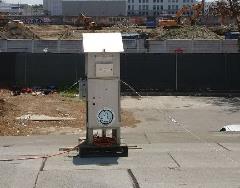Jordan Downs is a public housing apartment complex in the Watts community of Los Angeles. Built by the Federal Government in the mid-1940s, Jordan Downs was the first Veterans Housing Project in the country. The complex is bounded by Grape Street to the west, 97th Street to the north, Alameda Street to the east, and 103rd Street to the south, and is owned and managed by the Housing Authority of the City of Los Angeles (HACLA).
Between 1928 and 1938, the vacant L-shaped area adjacent to the Jordan Downs housing complex (see image below), here referred to as Jordan Downs Redevelopment Cleanup, was used for agricultural purposes. In the early 1940s, the site was developed for use as a steel manufacturing facility. Historical records show that after steel manufacturing activities ended in 2000, the property was used as a truck storage and repair facility.
In August 2014, the California Department of Toxics Substances Control (DTSC) identified contaminants in the soil from industrial operations at the site consistent with steel manufacturing, trucking-related operations and the storage of engine oil and oil wastes, fuels (diesel and gasoline), paint thinner and electric transformers. DTSC is responsible for the clean-up operation and indicated that there is no immediate risk to the community surrounding this site because the public is not directly exposed to the contaminated soil.

The South Coast Air Quality Management District (South Coast AQMD) conducted short-term air monitoring to supplement DTSC measurements and assess ambient levels of lead and arsenic during cleanup efforts performed April through May 2016.
Air sampling devices (like the one shown on the left) were placed at locations identified as Site #1 and Site #2 above.
Air samples collected by these monitoring devices were analyzed by the South Coast AQMD Laboratory. Sample analysis results can be downloaded below.
For reference, the level of the U.S. EPA National Ambient Air Quality Standards (NAAQS) for lead is 150 ng/m3 (0.15 ug/m3). Also, South Coast AQMD conducted its Multiple Air Toxics Emission Study (MATES IV) to show region wide levels of ambient air metals. Annual averages of metals from the MATES IV Study can be found in Table IV-3 in the MATES IV Final Report Appendix IV.